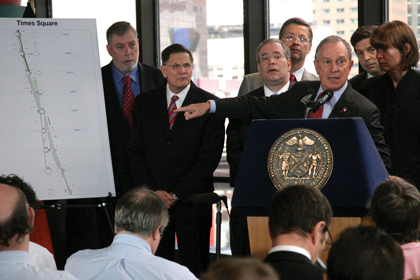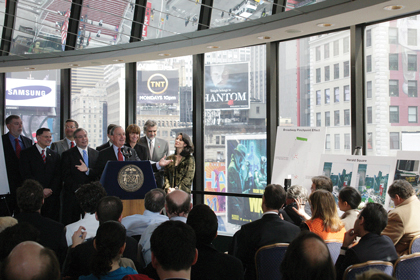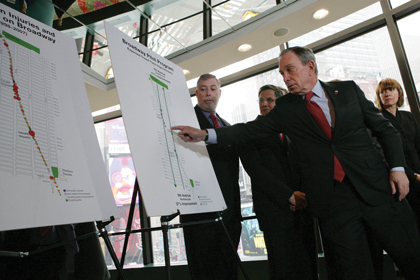MAYOR BLOOMBERG AND COMMISSIONER SADIK-KHAN ANNOUNCE PILOT "GREEN LIGHT FOR MIDTOWN" PROGRAM TO REDUCE CONGESTION
PILOT TARGETED TO REDUCE CONGESTION IN MIDTOWN

Mayor Michael R. Bloomberg and Department of Transportation Commissioner Janette Sadik-Khan announced a pilot program, "Green Light for Midtown," to reduce traffic congestion throughout Midtown Manhattan via targeted improvements on Broadway focused at Times and Herald Squares.
Despite attempts over several decades to address congestion caused by Broadway, the street has remained a significant traffic problem disrupting the grid of avenues and streets, creating complicated intersections and negatively impacting traffic flow throughout Midtown Manhattan. The Mayor and Commissioner Sadik-Khan were joined by Manhattan Borough President Scott Stringer, Times Square Alliance President Tim Tompkins, and Macy's Senior Vice President for Government and Community Relations Ed Goldberg at the Marriott Marquis Hotel in Times Square.
"Time and time again we've worked to find innovative, practical solutions to our most pressing challenges - whether that's to improve the City's environment, combat illegal guns, or reduce congestion," said Mayor Bloomberg. "By making targeted adjustments at Broadway's two main pinch points we believe we can ease traffic congestion throughout the Midtown grid. We are going to closely monitor the results to determine if this pilot works and should be extended beyond its trial period."
"For Midtown traffic Broadway is a problem hidden in plain sight," said Commissioner Sadik-Khan. "We're going to the heart of the matter and piloting a simple solution to a complex problem. The 'Green Light for Midtown' plan will work with the grid instead of against it, correcting the complicated intersections that create traffic congestion while creating enough space to enhance safety."
The pilot program will discontinue vehicular traffic on Broadway from 47th Street to 42nd Street and from 35th Street to 33rd Street connecting Seventh Avenue through Times Square where it is currently bisected by Broadway, and improving traffic flow on Sixth Avenue through Herald Square. The result will be simplified traffic patterns, longer green lights and reduced travel times throughout Midtown Manhattan. East/West vehicular access through Times and Herald Squares will not be impacted and travel times are expected to improve on some of those streets.
By cutting south at a diagonal, Broadway, which has 20 percent slower travel times than other avenues, disrupts the grid of avenues and streets and impacts traffic throughout Midtown Manhattan heavily contributing to:
- Traffic on Seventh Avenue through Times Square being 43 percent slower than it is south of 42nd Street,
- Traffic on Sixth Avenue moving 31 percent faster after passing the congested, four block approach to 34th Street, E2 Midtown traffic on Sixth and Seventh Avenues averaging only about 5 miles per hour with the slowest speeds and most congestion concentrated at Times and Herald Squares,
- Reduced traffic speeds on Ninth Avenue and Eighth Avenue.
By addressing the two most problematic sections of Broadway, Times and Herald Squares, congestion relief will cascade to nearby avenues. Once the pilot program is fully in place travel times are expected to decrease from 59th street to 23rd Street by up to:
- 17 percent on Seventh Avenue,
- And 37 percent on Sixth Avenue,
- Additionally, bus travel times will improve on the avenues for the more than 75,000 daily passengers on routes through the area.

"Broadway is the backbone of some of Manhattan's proudest landmarks and tourist attractions," said Manhattan Borough President Scott M. Stringer. "Comprehensive transportation steps like this one can enhance the quality of life of pedestrians and retail activity of Times and Herald Squares. I applaud Mayor Bloomberg and Department of Transportation Commissioner Janette Sadik-Khan for coming up with a solution that makes our city faster, safer, stronger and greener."
"We have a problem with traffic and crowding, and this may be the solution. While there are details to be worked out, this experiment is a thoughtful and creative approach to our persistent problems - gridlock, pedlock and thousands of people walking dangerously in the street for lack of space," said Tim Tomkins, President of the Times Square Alliance. "We may not know yet whether this idea will work, but we support the Mayor's willingness to search for creative solutions to traffic and pedestrian congestion in Times Square."
"The time for improving congestion at Herald Square - Macy's front yard - is long overdue," said Ed Goldberg, Senior Vice President for Government and Community Relations at Macy's. "This project will create a much safer and more enjoyable experience for everyone at this important shopping and transportation hub, and we applaud Mayor Bloomberg for taking this innovative and exciting approach."
"Creating more room and a safer environment for pedestrians has been a priority of ours for years," said Dan Biederman, President of the 34th Street Partnership. "We strongly support the efforts of Mayor Bloomberg and the Transportation Department to improve the Broadway corridor for the benefit of the area's workers, shoppers and businesses."
At Herald Square the project will increase the amount of time the light is green for vehicles traveling northbound on Sixth Avenue by 66 percent, unclogging a major traffic choke point, improving travel times for deliveries, emergency vehicles and others on the street.
At Times Square, where currently all Seventh Avenue traffic is forced onto Broadway, capacity will be increased by eliminating the lane squeeze where Seventh Avenue is reduced from four travel lanes to three between 47th and 44th Streets. By opening a new fourth lane at that location and making an 8 percent increase in green signal time for cars on Seventh Avenue at Times Square there is expected to be an overall reduction of 20 percent travel time along Seventh Avenue approaching Times Square.
In addition to the congestion relief pilot at Times and Herald Squares, Broadway's approach to Times and Madison Squares will receive street treatments similar to those installed last year on Broadway between 42nd and 35th Streets and at Madison Square.

With traffic discontinued on Broadway at Times and Herald Squares new pedestrian plazas will be created on Broadway from 47th to 45th Streets, from 45th to 42nd Street and from 35th to 33rd Street. The plazas will provide more than 2 1/2 acres of new public space for shoppers, office workers, and tourists, allowing for increased foot traffic - a potential boon for tourism and sales at local stores and restaurants, particularly during difficult economic times. Businesses located in the area around the improvements at Madison Square have responded favorably to the changes there.
Broadway's safety record is affected by the complex intersections it creates and the heavy pedestrian traffic at Times and Herald Squares. Each square serves as a mass transit hub with 75,000 bus passengers traveling through daily and sub way stations with more than 300,000 daily fares. Times Square alone sees over 356,000 pedestrians each weekday. The complex intersections and pedestrian traffic cause Times Square, for example, to see 137 percent more vehicle pedestrian accidents than at adjacent avenues. The improvements announced today will greatly reduce the number of points where vehicles and pedestrians cross each other which is intended to reduce the high accident rates. At locations where previous improvements have been made to Broadway - from 42nd Street to 35th Street - traffic injuries are already down 50 percent.
The pilot program will maintain a fire lane in Times and Herald Squares free of fixed objects at all times so emergency response vehicles will have full access.
Work on the pilot traffic improvements to Broadway will begin Memorial Day weekend with traffic being diverted from Broadway beginning that weekend. All work will be completed by September. The results of the pilot will be tracked closely through the end of the year to determine if the program should continue. The estimated cost of the pilot is $1.5 million.
© 2015 TLC Magazine Online, Inc. |